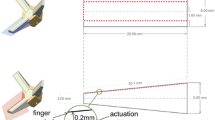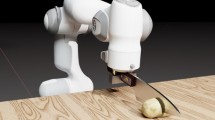Abstract
Purpose
Surgical robots are increasingly common, yet routine tasks such as tissue grasping remain potentially harmful with high occurrences of tissue crush injury due to the lack of force feedback from the grasper. This work aims to investigate whether a blended shared control framework which utilizes real-time identification of the object being grasped as part of the feedback may help address the prevalence of tissue crush injury in robotic surgeries.
Methods
This work tests the proposed shared control framework and tissue identification algorithm on a custom surrogate surgical robotic grasping setup. This scheme utilizes identification of the object being grasped as part of the feedback to regulate to a desired force. The blended shared control is arbitrated between human and an implicit force controller based on a computed confidence in the identification of the grasped object. The online identification is performed using least squares based on a nonlinear tissue model. Testing was performed on five silicone tissue surrogates. Twenty grasps were conducted, with half of the grasps performed under manual control and half of the grasps performed with the proposed blended shared control, to test the efficacy of the control scheme.
Results
The identification method resulted in an average of 95% accuracy across all time samples of all tissue grasps using a full leave-grasp-out cross-validation. There was an average convergence time of \(8.1 \pm 6.3\) ms across all training grasps for all tissue surrogates. Additionally, there was a reduction in peak forces induced during grasping for all tissue surrogates when applying blended shared control online.
Conclusion
The blended shared control using online identification more successfully regulated grasping forces to the desired target force when compared with manual control. The preliminary work on this surrogate setup for surgical grasping merits further investigation on real surgical tools and with real human tissues.




Similar content being viewed by others
References
De S, Rosen J, Dagan A, Hannaford B, Swanson P, Sinanan M (2007) Assessment of tissue damage due to mechanical stresses. Int J Robot Res 26(11–12):1159–1171
Dockter R, O’Neill J, Stephens T, Kowalewski T (2016) Feasibility of tissue classification via da vinci endowrist surgical tool. In: Hamlyn symposium on medical robotics, pp 64–65
Dragan AD, Srinivasa SS (2013) A policy-blending formalism for shared control. Int J Robot Res 32(7):790–805
Enes A, Book W (2010) Blended shared control of zermelo’s navigation problem. In: American control conference (ACC), 2010, IEEE, pp 4307–4312
Fung Y (1981) Biomechanics: mechanical properties of living tissues. Springer, New York
Li Y, Hannaford B (2017) Gaussian process regression for sensorless grip force estimation of cable-driven elongated surgical instruments. IEEE Robot Autom Lett 2(3):1312–1319
MacFarlane M, Rosen J, Hannaford B, Pellegrini C, Sinanan M (1999) Force-feedback grasper helps restore sense of touch in minimally invasive surgery. J Gastrointest Surg 3(3):278–285
Marucci DD, Shakeshaft AJ, Cartmill JA, Cox MR, Adams SG, Martin CJ (2000) Grasper trauma during laparoscopic cholecystectomy. Aust N Z J Surg 70(8):578–581
Mirheydar HS, Parsons JK (2013) Diffusion of robotics into clinical practice in the united states: process, patient safety, learning curves, and the public health. World J Urol 31(3):455–461
Okamura AM (2004) Methods for haptic feedback in teleoperated robot-assisted surgery. Ind Robot Int J 31(6):499–508
Peters JH, Gibbons G, Innes J, Nichols K, Roby S, Ellison E (1991) Complications of laparoscopic cholecystectomy. Surgery 110(4):769–77
Sakellariou P, Protopapas AG, Voulgaris Z, Kyritsis N, Rodolakis A, Vlachos G, Diakomanolis E, Michalas S (2002) Management of ureteric injuries during gynecological operations: 10 years experience. Eur J Obstet Gynecol Reprod Biol 101(2):179–184
Sie A, Winek M, Kowalewski TM (2014) Online identification of abdominal tissues in vivo for tissue-aware and injury-avoiding surgical robots. In: 2014 IEEE/RSJ international conference on intelligent robots and systems (IROS 2014), IEEE, pp 2036–2042
Steele SR, Maykel JA, Champagne BJ, Orangio GR (2014) Complexities in colorectal surgery: decision-making and management. Springer, Berlin
Tholey G, Desai JP, Castellanos AE (2005) Force feedback plays a significant role in minimally invasive surgery: results and analysis. Ann Surg 241(1):102–109
Wagner CR, Stylopoulos N, Jackson PG, Howe RD (2007) The benefit of force feedback in surgery: examination of blunt dissection. Presence Teleoper Virtual Environ 16(3):252–262
Winkler A, Suchỳ J (2015) Implicit force control of a position controlled robot—a comparison with explicit algorithms. World Acad Sci Eng Technol Int J Comput Electr Autom Control Inf Eng 9(6):1454–1460
Yu X, Chizeck HJ, Hannaford B (2007) Comparison of transient performance in the control of soft tissue grasping. In: IEEE/RSJ international conference on intelligent robots and systems, 2007. IROS 2007, IEEE, pp 1809–1814
Funding
This material is based upon work supported by the National Science Foundation Graduate Research Fellowship under Grant No. 00039202. Any opinion, findings, and conclusions or recommendations expressed in this material are those of the authors and do not necessarily reflect the views of the National Science Foundation.
Author information
Authors and Affiliations
Corresponding author
Ethics declarations
Conflict of interest
Robert Sweet is a consultant for Olympus-Advisory for endourologic applications. Robert Sweet is chief executive officer for Simagine Health-Distributing simulation training solutions.
Ethical standard
This article does not contain any studies with human participants or animals performed by any of the authors.
Informed consent
This articles does not contain patient data.
Additional information
Research was sponsored in part by the National Science Foundation Graduate Research Fellowship under Grant No. 00039202. Any opinion, findings, and conclusions or recommendations expressed in this material are those of the authors and do not necessarily reflect the views of the National Science Foundation.
Rights and permissions
About this article
Cite this article
Stephens, T.K., Kong, N.J., Dockter, R.L. et al. Blended shared control utilizing online identification. Int J CARS 13, 769–776 (2018). https://doi.org/10.1007/s11548-018-1745-3
Received:
Accepted:
Published:
Issue Date:
DOI: https://doi.org/10.1007/s11548-018-1745-3




